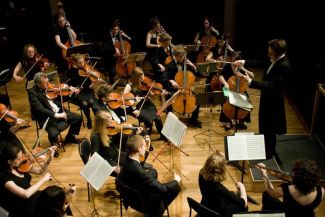What if the chandelier in The Phantom of the Opera crashed to music amplified from an iPod? What if you saw West Side Story, but the “Mambo” was synthesized using a “virtual” army of keyboards? Would your experience still be the same?
The answer, for many, would probably be “no.”
Throughout the history of the American musical theatre, composers and orchestrators have sculpted scores and melodies to be played by a group of musicians with the utmost skill and mastery. But, what if that was all gone? The tragic reality is that this is a definite possibility.
With the advent of more advanced digital recording technologies, producers of big budget musicals on Broadway have figured out a way to maximize their profits without losing any production value (at least in their mind): shrinking the orchestra. Recent productions of new musicals have come under fire for their use of string synthesizers instead of string sections, most famously in the production of Priscilla, Queen of the Desert, which ran at the Palace Theatre.
The revivals of classic works of musical theater, however, have also received criticism. In 2010, after 500 performances of the revival of West Side Story, the production decided to make a change to the orchestra size without changing the orchestration.
“Our producers have told us and our union that in order to cut costs they will chop our string section in half, releasing five musicians and “replacing” them with a synthesizer piped in from another room,” Paul Woodiel, a violinist in the production and a friend of the late Leonard Bernstein, the composer of West Side Story, wrote in a 2010 op-ed in The New York Times. “I don’t think Lenny [Bernstein] would have approved.”
Producers are willing to sacrifice the artistic quality of the piece and the full realization of the composer’s score in order to cut their own costs, perhaps to keep a show running longer. Cutting the size of an orchestra can be a way to keep a show open longer in order to recoup the producers’ initial investments. Musicians like Woodiel have suggested that if these producers understood the importance of live music, they would be less willing to sacrifice the quality of the work.
“If the show is no longer profitable, the producers should simply close it with its dignity intact.” Woodiel wrote. “Doing so might put me out of work, but it would honor (rather than demean) the legacy of Bernstein’s crown jewel [West Side Story].”
Broadway production houses, however, are not the only offenders in the push towards recorded music in the performing arts, and these actions are evident: In her New York Times review Matthew Bourne’s 2010 production of Swan Lake at the New York City Center, Gia Kourlas, cited that the use of recorded music was very noticeable.
“The lack of an orchestra, especially in a show that retells the music as much as the dance, was singularly felt,” she wrote.
Thankfully, though, situations like the ones Woodiel and Kourlas describe are not always the case. In fact, the recent revival of Follies in 2011, produced by the Kennedy Center for the Performing Arts, featured a 29-piece orchestra, which, at the time, was the largest on Broadway. This number was well above the minimum agreed to by the musicians’ union and the Broadway League, which represents Broadway producers, for Follies’ theatre the Marquis, whose minimum is 19. In addition, the new musical A Gentleman’s Guide to Love and Murder features a 12-piece orchestra, much greater than the minimum for its theater the Walter Kerr, whose minimum is three.
Despite the fine examples of producers producing shows the right way with full orchestrations, this issue still deserves attention.
If we, as a theatre-going public, allow producers to simply cut and snip musicians and trim orchestrations, we will soon be confronted with a totally digitized Broadway orchestral sound. It is a slippery slope if there ever was one: a slope that could force musicians out of the theatre and eliminate live music from American stages.
Richard Bordelon, FCRH ’15, is a history and political science major from New Orleans.





